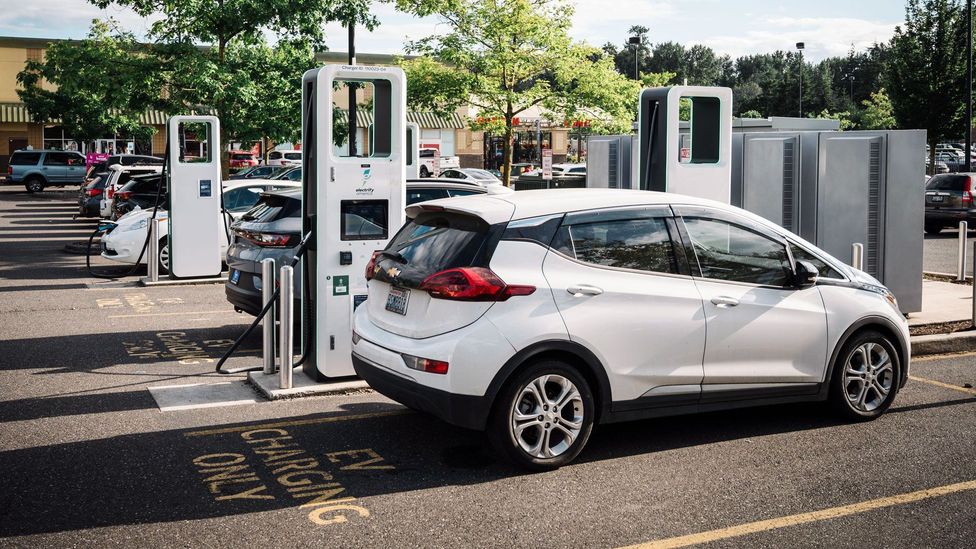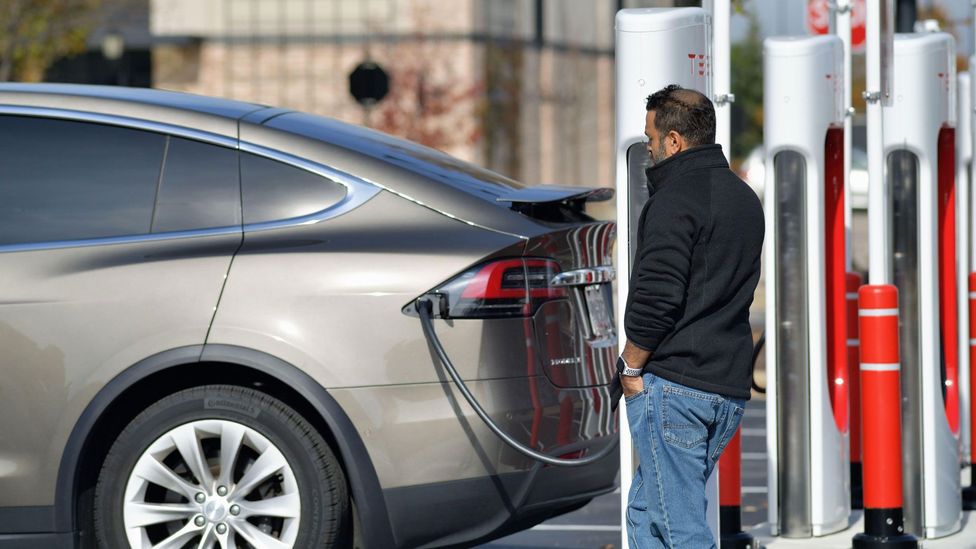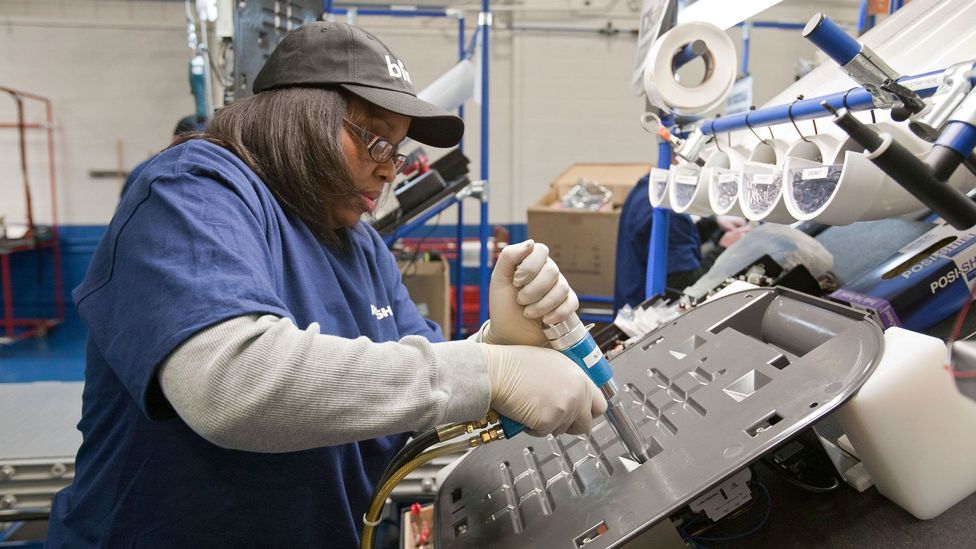Kate Morgan

Throughout the past few years, analysts have touted electric vehicles as the future of transport – one Americans would dive into, eagerly and rapidly. The EV market is indeed expanding, but the US's electric vehicle 'revolution' appears to be happening much slower than some analysts and car manufacturers expected.
Since 2016, sales of EVs in the US have grown – from nearly 65,000 vehicles sold in 2017, to more than 800,000 vehicles in 2022. Data from auto analytics firm Motor Intelligence showed EV sales rose 51% in the first half of 2023, following the upwards trend. However, those gains are still a drop from last year's 71% growth in the same timeframe. And Tesla, which leads the market with more than half of all EV sales, recently reported its lowest quarterly earnings in two years, leading to a $138bn (£111.4bn) drop in the company's stock value.
Some American car manufacturers are taking new business decisions based on these signals.
General Motors – which two years ago announced a goal of phasing out internal combustion engines by 2035 – is pulling away from a production goal of 400,000 EVs by mid-2024. They've also cancelled plans to pair with Honda to build a line of more affordable EVs. At Ford, executives are delaying billions of dollars in EV investment, saying they don't yet need the production capacity to meet demand.
It's not that Americans don't wantto buy EVs, says Elizabeth Krear, vice president of Electric Vehicle Practice at consumer-intelligence firm J.D. Power.
"We survey over 2,000 new vehicle shoppers to gauge their interest in EVs every single month," she says. "In October, the percentage of new vehicle shoppers very likely to consider a full-battery electric vehicle reached an all-time high of 29.2%. So, almost one out of every three new vehicle shoppers are very likely to consider an EV for their next vehicle purchase."
Yet a few core reasons have slowed the progress of EV adoption for US drivers – barriers that need solutions before American uptake can skyrocket as forecasted.
The affordability issue
Chief among these roadblocks is affordability. Even as prices come down, and the US introduces tax credits, EVs remain much more expensive than their combustion counterparts. With US interest rates at a two-decade high, the price tag for the average American car shopper is prohibitive.

Teslas have the largest EV market share, and are generally owned by upper-income individuals.
"We looked at 13 years' worth of electric vehicle prices in the US, and in inflation-adjusted dollars, the average price of an EV is going up, not down," says Ashley Nunes, a senior research associate at Harvard Law School. This is quite problematic: if an everyday consumer is looking at the price of an EV and a gasoline powered car and seeing, depending on the day, a difference between $15,000 and $20,000 (£12,195 and £16,260), it's pretty easy to figure out which option they're going to select."
Government programs strive to make prices more palatable, offering incentives to EV buyers. There's a federal subsidy of $7,500 (£6,060) towards the purchase price, and several states offer an additional credit between $1,000 and $7,500 (£813 and £6,060). These extra incentives seem to be a determining factor as to whether consumers will make the purchase, says Krear: "Of the top 10 adoption states, five of them have state incentives."
Yet they're not in place everywhere yet, and Nunes says even the incentives don't do much to move the needle on a wide scale.
Ultimately, they still can't bring the price of an EV below that of a petrol-powered car, or into the realm of affordability for the average consumer. "The median income for a family of four is somewhere around $70,000 (£56,915). The average electric car in 2022 cost more than $60,000 (£48,784). So, think about that: the near equivalent of what you're pulling in for the year," he says.
Due to this prohibitive pricing, he adds "the majority of electric cars are currently purchased by upper-income individuals". Tesla manufactured four of the top 10 most popular electric vehicles sold in 2023, ranging in base price from $35,000 (£28,450) for the Model Y to $101,000 (£82,120) for the Model X; the average Tesla owner according to Market Research firm Hedges & Company, had a household income near $150,000 (£121,200) in 2022.
Plus, while petrol-powered cars need maintenance and, of course, petrol, the cost of an electric car doesn't end on the lot. In some states, EVs are more expensive to register. Some require their owners to pay regular subscription fees for services, and repairs are more costly. Plus, the fluctuating cost of electricity means it's not always cheaper to fuel an EV, either, if the owner charges off their own supply.
Charging is a challenge
Beyond the expense of installing a home charger, says Nunes, there's another barrier to powering EVs for many average Americans: there's nowhere to put those chargers.
"It might make sense [to buy an EV] if you could recharge that vehicle in the driveway of your house while you're asleep," he says. "The problem is that many Americans don't even have driveways." J.D. Power's Krear adds that "one in three shoppers don't have access to home charging".
At this point, even figuring in the drive to a fossil-fuel station, "it's still much easier to refuel your vehicle with gasoline than with electrons", says Nunes. "If you pull up to a gas station with an empty tank, and you just pump it full of gas, it'll take you maybe six, seven minutes at the most. With EVs, it's going to take you hours to charge that vehicle to the maximum rate. And that's the kind of time that everyday Americans simply don't have."
Experts agree that establishing a robust infrastructure of public charging stations is key to mass adoption of EVs. But the creation of that infrastructure lags. Stations are scarce, particularly in low-income and minority communities. Where they do exist, they are often unreliable.
"One out of every five public charging attempts is a failure," says Krear. Findings from a 2022 University of California, Berkely study showed that one-quarter of public chargers in the San Francisco Bay Area didn't work due to "unresponsive or unavailable screens, payment system failures, charge initiation failures, network failures, or broken connectors".
As the number of EVs on the road outpaces charger installation, Krear says these issues lead to a lack of public confidence in the ability of legislators and manufacturers to create a fully functioning infrastructure in the very near future, which can ultimately erode consumers' faith that an EV is the right solution for them.
A supplement, not a replacement
Booms in EV sales in recent years, says Nunes, were led by early adopters – people for whom an EV was an easy sell. Now, most of the people interested in owning an EV already do. Middle-income Americans ought to be the next target group of buyers, but he believes companies have failed to engage them to jump into the market.
Additionally, even consumers who have purchased EVs are not outright replacing petrol-powered vehicles. Instead of fully transitioning to electric power, consumers are often supplementing their personal fleets.
"There's very strong evidence that shows most of the individuals who buy electric cars also own an internal combustion engine-powered vehicle," says Nunes. "They're not giving up their gasoline cars for the electric car. The majority of electric cars are purchased as what economists call 'complements', not substitutes. They're just adding to the total number of cars in their inventory."
Part of the issue, says Krear, is that buyers who are looking for a replacement may not be able to find an EV that fits the bill. "I often hear people say things like, 'I can't buy an EV until there's a large SUV available. I've got carpool, and four kids to pick up'. There needs to be availability in all segments, and currently there is not."

Both car manufacturers and factory workers still believe there is a future in EV production.
She says coverage is about 40% – meaning 60% of shoppers looking for an EV model comparable to the petrol-powered car they want aren't going to find one.
An optimistic outlook
Krear says although only a small percentage of all cars currently on the road are EVs, throughout the next few years, "we do anticipate that share more than doubling from 9% to 19%". She believes many of the problems currently plaguing adoption will likely lessen, which will increase market share.
For instance, Krear says that as a variety of new models are introduced – including electric cars and SUVs – many consumers will increasingly find an electric vehicle that can sufficiently replace a petrol-powered model in the coming years. "We project that by 2026, 75% of the market scope will be covered. So, three out of four new vehicle shoppers will have a viable substitute to an internal combustion engine."
There is also a push to make sure that EV drivers also have access to a reliable network of public charging stations. The Biden administration has pledged to create a "convenient, reliable, and user-friendly national network of 500,000 EV chargers by 2030." (The public charging stations in Biden's plan will be universally compatible with all EVs, including Teslas, which also have their own proprietary chargers).
Working in tandem, these two solutions could subsequently bring down prices, enabling the widespread transition away from combustion engine vehicles experts predicted and car manufacturers have banked on.
For now, even as car manufacturers may have overestimated the speed with which Americans would adopt electric vehicles, there is still widespread faith among both manufacturers and workers that EVs are the future of the auto industry. The United Auto Workers (UAW) made EV technology a central position in their strike against US auto manufacturers GM, Ford and Stellantis earlier this year. The recent, tentative agreements struck with companies include stipulations that people building combustion engines and transmissions now will retain top union wages as the widespread transition to EV batteries and vehicles components ramps up.
Despite the challenges, or the slower-than-anticipated rate of great change, Krear says the EV revolution is still very much happening.
"Retail share is growing, consumer interest is growing, availability is growing," she says. "We do see prices coming down. We do see infrastructure initiatives taking place. We're seeing in the news that more automakers wanting to enter that discussion. There is a lot of initiative and yes, it's going to take a little bit of time for consumer confidence to catch up."
But over the next few years, she expects "we'll continue to see tremendous progress".
No comments:
Post a Comment